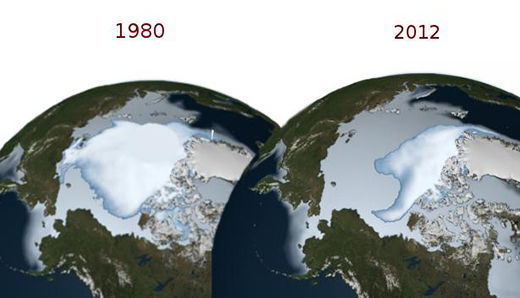
Another unsettling portent of climate change arrived March 24, when the warmest temperature ever recorded in Antarctica – 63.5°F (17.5C) – occurred at the Esperanza Base on the northern tip of the Antarctic Peninsula. It beat out a previous, and equally troubling, record set the day before (at 63.3°F). Though the World Meteorological Organization has not officially acknowledged the temperature to be a record-breaker yet, it has been verified by the Esperanza Base, according to Weather Underground, and the news is already piquing worried attention.
The Antarctic peninsula is one of the fastest-warming spots on the planet, and the record heat coincides with the release of a new study, which has declared, “Ice shelves in West Antarctica have lost as much as 18 percent of their volume over the last two decades, with rapid acceleration occurring over the last decade.” That ‘acceleration’ includes losses that have increased by 70 percent over those ten years. But even the larger ice shelves in Eastern Antarctica are at risk, the study notes. “The East Antarctic ice sheet is [also] vulnerable. Some data suggests its fringing ice shelves may be thinning, too.”
“Parts of Antarctica are melting so rapidly it has become ground zero for climate change, without a doubt,” said Harvard geophysicist Jerry X. Mitrovica. This continuous melt does not bode well for North America, and is also impactive on a grander scale: when glaciers melt, the redistribution of their mass causes changes in the earth’s rotational axis. “The earth isn’t a perfect sphere,” said Mitrovica. “It’s flattened because it’s rotating. If you move the pole, the flattening adjusts.” If even just the West Antarctic sheet collapsed, the pole would move such that sea levels would rapidly rise in North America; water levels in Boston, the District of Columbia, and other sites along the east and west coasts would rise over 30 percent more than the global average.
Though this projection is disturbing, the consequences won’t be immediate, said Mitrovica. But the fact that sea levels are already rising more than older models had originally predicted is still cause for some alarm, with areas in the U.S. still very much vulnerable to the continuing havoc wreaked by a warming climate.
Andrew Shepherd, director of the Center for Polar Observation and Modelling at the University of Leeds, added, “There is a real concern, because such high rates of thinning cannot be sustained for much longer, and because in the places where Antarctic ice shelves have already collapsed, this has triggered rapid increases in the rate of ice loss from glaciers above ground, causing global sea levels to rise.”
University of California, San Diego researcher Fernando Paolo remarked, “If the loss rates that we observed in the past two decades are sustained, some entire ice shelves in the Amundsen and Bellingshausen seas could disappear within this century.”
Climate deniers and skeptics often like to point out that there has been no visibly demonstrable rise in sea levels despite what experts have been saying. Paolo had a rather obvious explanation for that: “This is just like your glass of gin and tonic. When the ice cubes melt, the level of liquid in the glass does not rise.” Logic, of course, completes the unfinished statement: Try dumping twenty more ice cubes into that glass, and watch what happens.
Photo: The long-term decline in Arctic sea ice is illustrated in these two startlingly contrasting graphics. Rocky Rex Science







